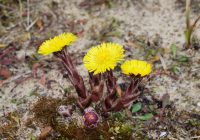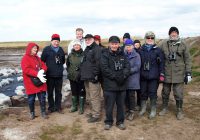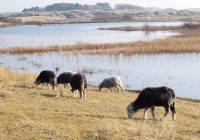Dr Phil Smith’s Wildlife Notes
March 2013
March can often be grim but this one took some beating; it was the coldest March since 1962, persistent high pressure over Scandinavia pulling in winds from Siberia. At least we were lucky with the snow which smothered large parts of the country on 22nd, deep drifts causing chaos. Here, there was only an inch or so and it didn’t last long.
With temperatures averaging 3.6 degrees C below normal, it was not surprising that most spring flowers and migrant birds were in short supply. Snowdrops were still in full flower at the end of the month, something I have never seen before, while the usual dune annuals were almost non-existent. In the first week, I went to see the rare Green Snowdrop at Hesketh Road, Marshside, where there are now nine large plants, and then the Large Snowdrop that I found for the first time in February 2012 at Kenilworth Road dunes. All three Snowdrop species are non-native of course, having escaped from gardens. Nevertheless, they produce an attractive display at a time of year when not much else is flowering.
One or two Wheatears were reported from mid-March but my first was not until 26th when I bumped into a smart male at Weld Road shore, Birkdale. Although a few Skylarks were singing that afternoon, the icy breeze was more reminiscent of January.
Despite the conditions, a few other birds were on the move, a visit to Ravenmeols on 5th being rewarded with three Waxwings trilling away on top of a dead pine. Equally interesting was an influx of Jack Snipe in mid-month, perhaps beginning their migration back to Scandinavian breeding haunts. I counted seven of these superbly camouflaged waders on 17th in the Weld Road salt-marsh, the same number being seen two days later at the southern end of the Birkdale Green Beach, where the first Colt’s-foot flowers made a welcome splash of colour. Jack Snipe are always hard to find as they don’t move until you are about to tread on them. More winter birds were at Cabin Hill National Nature Reserve on 21st, the deeply flooded wetlands producing a record count of 70 Teal and a Water Rail A few days later, a pair of Shoveler ducks were new to that reserve.
Hoping to find a spring Chiffchaff, I strolled through the Ravenmeols woods on the last day of the month. None was to be heard, though a Great Spotted Woodpecker was drumming away on a hollow tree and I counted 36 Redwings on the nearby school playing fields. Plenty of Daffodils were blooming on the woodland fringes, again garden cultivars rather than the native species, while the first Lesser Celandines were showing on Range Lane.
One of the month’s highlights was a West Lancashire Wildlife field trip on 30th to Lunt Meadows to see the new wetland project. Steve White of the Lancashire Wildlife Trust guided us round this 70ha site which will be used for flood storage during high rainfall. It will also be managed as a nature reserve, with extensive reed-beds, grazing marsh and species-rich grassland. Although not yet complete, the site is already attracting plenty of birds and we saw a Short-eared Owl and an early Little Ringed Plover, as well as a wide variety of ducks. Particularly fascinating was the recently excavated 8000-year-old Mesolithic settlement that was featured on a TV programme earlier in the year.
Management to maintain the richness of our wonderful dunes never stops. I was pleased to see that volunteers had removed a large area of scrub choking the life out of the Montagu Road dune-heath, Freshfield. Five Shetland cattle browsed the willows at Cabin Hill, while flocks of Herdwick sheep here and at Ainsdale dealt with the dense grass growth from last summer. Tragically, 17 of the Ainsdale sheep were killed by a large dog or dogs, meaning the survivors had to be sent back to Cumbria early and just in time for the blizzard.




